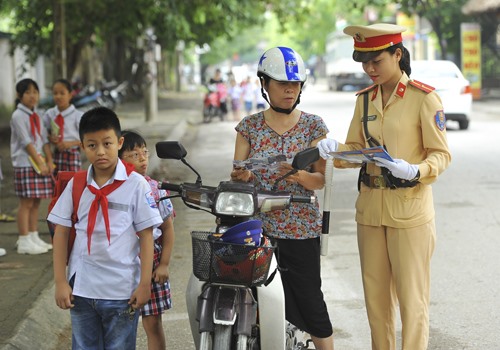 Society
Society

Wearing helmets and driving slowly are two of the measures promoted to ensure traffic safety for children, announced at a ceremony launching the ‘Go home safely’ campaign in Hà Nội on Saturday, which calls for community action to ensure kids are safe on the roads.
 |
| A traffic policewoman in Ninh Binh Province gives a mother leaflets with knowledge and information on the need for her children to wear helmets. — VNA/VNS Photo Minh Đức |
HÀ NỘI — Wearing helmets and driving slowly are two of the measures promoted to ensure traffic safety for children, announced at a ceremony launching the ‘Go home safely’ campaign in Hà Nội on Saturday, which calls for community action to ensure kids are safe on the roads.
Traffic accidents are the second major cause of child fatalities in Việt Nam after drowning, said Deputy Minister of Labour, Invalids and Social Affairs, Đào Hồng Lan, at the launch ceremony, which was jointly held by the Ministry of Labour, Invalids and Social Affairs and the UN Children’s Fund (UNICEF).
Lan said that traffic accidents were the cause of 50 per cent of deaths among adolescents and youngsters aged 15-19.
She stressed that injuries to kids stemming from road accidents can be avoided by raising public awareness of traffic safety regulations and laws.
The use of helmets is an effective way to protect children, as it can reduce the risk of death by up to 40 per cent, and the risk of serious injury by 70 per cent, she stated, adding that if drivers reduce their average speed by just 5 per cent, fatal accidents are cut by 30 per cent.
Meanwhile, Yoshimi Nishino, UNICEF Acting Chief Representative in Việt Nam, noted that every day, about 2,000 people die in traffic accidents, including 500 children, worldwide. One child dies every four minutes on the road, while 50 per cent of traffic accident victims are pedestrians, bicycle and motorbike riders, she added.
In Việt Nam, the National Committee for Traffic Safety reported that in 2016, traffic accidents killed nearly 9,000 people and left thousands of others injured, said Yoshimi Nishino.
She lauded Việt Nam’s efforts in proactively implementing global road safety initiatives with specific steps to build effective traffic law.
The UNICEF official called on the community to wear helmets for both adults and children when riding bicycles and motorbikes, and reduce speeds when driving through densely-populated areas.
At the event, representatives of ministries, sectors, localities, schools, parents and students signed commitments to wear helmets and drive slowly for the safety of children. — VNS




